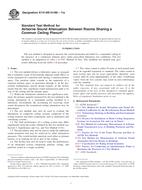Potrebujeme váš súhlas na využitie jednotlivých dát, aby sa vám okrem iného mohli ukazovať informácie týkajúce sa vašich záujmov. Súhlas udelíte kliknutím na tlačidlo „OK“.
ASTM E1414/E1414M-11a
Standard Test Method for Airborne Sound Attenuation Between Rooms Sharing a Common Ceiling Plenum (Includes all amendments And changes 10/13/2014).
Automaticky preložený názov:
Štandardná skúšobná metóda pre výsadkovej útlmu medzi miestnosťami zdieľanie spoločného strop Plénum
NORMA vydaná dňa 1.11.2011
Informácie o norme:
Označenie normy: ASTM E1414/E1414M-11a
Poznámka: NEPLATNÁ
Dátum vydania normy: 1.11.2011
Kód tovaru: NS-41682
Počet strán: 8
Približná hmotnosť: 24 g (0.05 libier)
Krajina: Americká technická norma
Kategória: Technické normy ASTM
Anotácia textu normy ASTM E1414/E1414M-11a :
Keywords:
airborne sound attenuation, common ceiling plenum, suspended ceiling, Ceiling suspension systems, Chamber construction (for airborne sound attenuation test), Impact sound transmission (building elements), Acoustical tests, Plenums, Rooms, Sound transmission--building materials/applications, Sound transmission--office environments, ICS Number Code 91.120.20 (Acoustics in buildings. Sound insulation)
Doplňujúce informácie
| Significance and Use | ||||||||||||||||
|
Modern offices and other multipurpose buildings commonly have suspended acoustical ceilings installed over room dividing partitions. The test facility prescribed in this test method is useful for providing ceiling attenuation data on the relevant ceiling/partition elements and systems, to ensure that the transmission of sound through the ceiling and plenum space, or through the combination of ceiling, plenum space, and partition systems, provides a suitable degree of acoustical isolation. This test method is useful for rating and specifying, under standardized conditions, the sound attenuation performance of ceiling materials when mounted in a specified suspension system. This test method may be useful for selecting a wall-ceiling system for probable compliance with a performance specification for overall sound isolation between rooms. However, the actual field performance may differ significantly, particularly if the field plenum depth is not within the limits specified in this test method or if the plenum space contains large ducts, beams, etc., or both. (See Test Method E336.) The flexibility inherent in the test facility enables evaluation of the effects of penetrations, induced leakage paths, luminaire, and air diffuser installations and discontinuities in the ceiling suspension system at the partition line, including penetration of the partition into the ceiling plenum. The effect of installing plenum barriers at the partition line may also be investigated. With the concentration of sound absorbent area offered by a suspended sound absorbent ceiling installed in a room, it is not possible to obtain a good approximation to a diffuse sound field in that room. The plenum dimensions prevent the maintenance of a diffuse sound field above the test specimen. These factors affect the values of the measured ceiling sound attenuation and thus the measurements are not a fundamental property of the ceiling. The test method measures the acoustical properties attainable under the prescribed test conditions, which have been arbitrarily selected. The conditions must be adhered to in every test facility so that the measured results will be consistent. Two methods for obtaining A, the receiving room absorption, are given without preference. One method, known as the steady state method, has been used to obtain an estimate for A in the AMA 1-II-1967 standard. The other method follows the procedures used in Test Methods E90 and C423; justification for the use of this method may be found in reference (1) . Persons wishing to further investigate the limitations imposed by this test method are advised to read references (2), (3), (4) and (5). Notwithstanding the above limitations, this type of test method has been used successfully for a number of years to rank order commercial ceiling systems and the test results are commonly used for this purpose. |
||||||||||||||||
| 1. Scope | ||||||||||||||||
|
1.1 This test method utilizes a laboratory space so arranged that it simulates a pair of horizontally adjacent small offices or rooms separated by a partition and sharing a common plenum space. The partition either extends to the underside of a common plenum space or penetrates through it. In the prescribed configuration, special design features of the facility ensure that the only significant sound transmission path is by way of the ceiling and the plenum space 1.2 Within the limitations outlined in the significance statement, the primary quantity measured by this test method is the ceiling attenuation of a suspended ceiling installed in a laboratory environment. By accounting for receiving room sound absorption, the normalized ceiling attenuation may be determined. 1.3 The test method may also be used to evaluate the attenuation of composite ceiling systems comprised of the ceiling material and other components such as luminaires and ventilating systems. 1.4 The field performance of a ceiling system may differ significantly from the results obtained by this test method (see Section 5, Significance and Use, and Test Method E336). 1.5 The procedures may also be used to study the additional sound insulation that may be achieved by other attenuation measures. This would include materials used either as plenum barriers or as backing for all or part of the ceiling. 1.6 The facility may also be used to study the performance of an integrated system comprising plenum, ceiling, and partition, tested as a single assembly. 1.7 The values stated in either SI units or inch-pound units are to be regarded separately as standard. The values stated in each system may not be exact equivalents; therefore, each system shall be used independently of the other. Combining values from the two systems may result in non-conformance with the standard. 1.8 This standard does not purport to address all of the safety concerns, if any, associated with its use. It is the responsibility of the user of this standard to establish appropriate safety and health practices and determine the applicability of regulatory limitations prior to use. |
||||||||||||||||
| 2. Referenced Documents | ||||||||||||||||
|
Odporúčame:
Aktualizácia technických noriem
Chcete mať istotu, že používate len platné technické normy?
Ponúkame Vám riešenie, ktoré Vám zaistí mesačný prehľad o aktuálnosti noriem, ktoré používate.
Chcete vedieť viac informácií ? Pozrite sa na túto stránku.




 Cookies
Cookies
